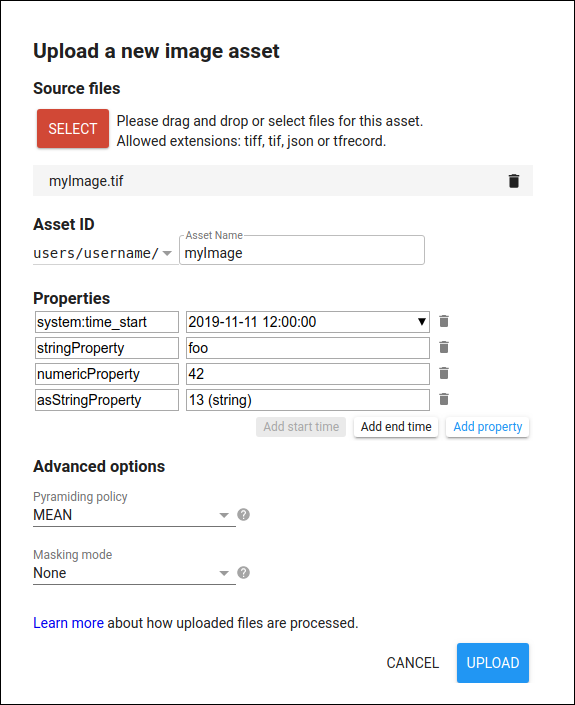How Long Does It Take for Goggle Shows Upload Images
Y'all can utilize the Nugget Director or control line interface (CLI) to upload image or other georeferenced raster datasets in GeoTIFF or TFRecord format. (See Importing Vector Data for details on importing vectors using the Code Editor.)
Uploading epitome assets
GeoTIFF
In the Code Editor, you tin upload GeoTIFF image files upward to 10 GB in size to your World Engine user folder. (For larger files, use the control-line upload option.)
To upload a GeoTIFF using the Lawmaking Editor, select the Assets tab in the upper left corner, click the  button, then select Image upload. Earth Engine presents an upload dialog which should look similar to Figure one. Click the SELECT button and navigate to a GeoTIFF on your local file organisation.
button, then select Image upload. Earth Engine presents an upload dialog which should look similar to Figure one. Click the SELECT button and navigate to a GeoTIFF on your local file organisation.
Requite the image an advisable asset ID (which doesn't already exist) in your user folder. If you'd like to upload the epitome into an existing binder or collection, prefix the nugget ID with the binder or collection ID, for example /users/name/binder-or-collection-id/new-asset.
Click UPLOAD to starting time the upload.

Once you have started the upload, an "Asset ingestion" task appears on the Tasks tab at the right side of the Code Editor. Hovering over the task in the task manager shows a ? icon which y'all can use to check the upload status. To abolish an upload, click on the spinning icon  side by side to the task. Once the ingestion is complete, the asset will appear in your user folder with a icon.
side by side to the task. Once the ingestion is complete, the asset will appear in your user folder with a icon.
TFRecord
To upload an paradigm from a TFRecord file, y'all must have the associated mixer file that was generated when yous exported imagery on which you lot performed inference. Meet the export page for details on the mixer file. More specifically, to import predictions (equally an image) made on exported imagery,
- Consign imagery into one or more TFRecord files.
- Perform inference on the imagery (i.eastward.
model.predict()). - Write the output of
model.predict()into a TFRecord file. The predictions should exist in the same order as the image exports on which you performed inference. Society can be enforced by a sort of the filenames produced by the export. See the large file exports section for details. - Upload the TFRecord file(due south) and associated mixer to Earth Engine.
Properties editing
Edit asset metadata past specifying ane or more metadata properties. In the Backdrop card, click Add holding to define a holding name and value (Figure ii). The value can exist a cord or a number. Enter strings without quotes. To format a number as a cord, enter a single quote (') before the number.
Past default, a organization:time_start property is added with no value. This property is used by Globe Engine when applying ImageCollection date filters. Enter either a date in the format shown in Figure 2, or a number representing milliseconds since January 1, 1970. (Run into the glossary for more data on timestamps in Earth Engine). The Asset Manager interprets a number entered as the value for a property named system:time_start or system:time_end as milliseconds and formats it as a date.
Click the icon to remove a property.
Advanced options
In the Advanced menu, choose the pyramiding policy and the masking fashion for your data.
The pyramiding policy specifies how Globe Engine generates lower resolution versions of the image. Acquire more about how Earth Engine handles multiple resolutions in the calibration doctor. Choose a 'Mean', 'Min', or 'Max' pyramiding policy to compute lower resolution levels of the image pyramid as the mean, minimum or maximum of each 2x2 grouping of college resolution pixels. This is a suitable option for continuous-valued images. For chiselled (due east.g. land cover) or QA data, choose a 'Sample' (the upper left pixel) or 'Mode' (most often occurring value, or sample if at that place is no fashion) pyramiding policy.
The masking mode indicates how the uploaded image is masked (if at all). To specify a no-information value, select 'No-data value' and enter the value. Pixels with this value volition be masked in the uploaded image. This value is applied to every band of the image independently. To use the terminal band of your image as a mask for the other image bands, select 'Utilise final band every bit blastoff band'. The blastoff band should be an unsigned viii-bit band where 0 is masked (completely transparent) data and 255 is completely opaque.
Tiled uploads
To upload a single prototype as multiple tiles, where each tile is stored in a different source file, click Add another file to add additional files to the upload. Earth Engine volition combine the tiles to create a single image in your user folder.
There are a few constraints on the types of files that can be uploaded into an epitome asset. In particular:
- The images must accept the same number of bands, bit depth, projection, resolution and fill values.
- The offset from one file to the adjacent must be an integer multiple of the pixel size.
- Gaps between tiles will be filled with masked pixels in the final prototype, so the tiles should ideally exist adjacent and non sparsely spread out. Images with gaps taking upward >99% of the image area won't be ingested.
Source: https://developers.google.com/earth-engine/guides/image_upload
0 Response to "How Long Does It Take for Goggle Shows Upload Images"
Post a Comment